
(a)
Interpretation:
The detailed mechanism for the given reaction is to be drawn and the major product of the reaction is to be predicted.
Concept introduction:
The addition reaction mechanism dominates on whether the nucleophile adds to the carbonyl carbon reversibly or irreversibly. Nucleophilic addition is irreversible or reversible depends on charge stability. Nucleophilic addition tends to be irreversible if the negative charge that develops in the adduct is substantially better stabilized than it is in the nucleophile. Nucleophilic addition to a carbonyl carbon tends to be irreversible when it involves a very strong nucleophile like
Answer to Problem 17.24P
The major product and mechanism for the given reaction are:
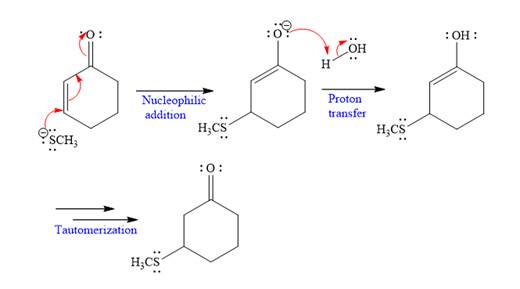
Explanation of Solution
The nucleophile
In the first step,
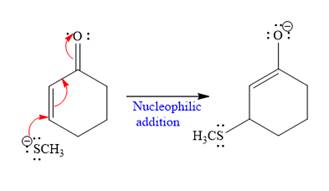
In the second step, this enolate anion is then protonated by an acid workup.
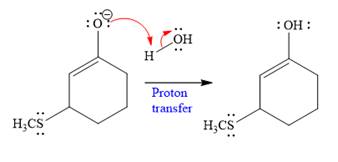
In the last step, tautomerization takes place and produces a ketone with a conjugate addition product.
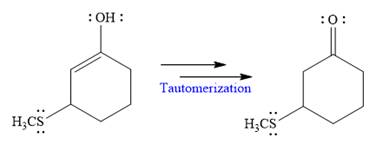
Nucleophilic addition of
(b)
Interpretation:
The detailed mechanism for the given reaction is to be drawn and the major product of the reaction is to be predicted.
Concept introduction:
The addition reaction mechanism dominates on whether the nucleophile adds to the carbonyl carbon reversibly or irreversibly. Nucleophilic addition is irreversible or reversible depends on charge stability. Nucleophilic addition tends to be irreversible if the negative charge that develops in the adduct is substantially better stabilized than it is in the nucleophile. Nucleophilic addition to a carbonyl carbon tends to be irreversible when it involves a very strong nucleophile like
Answer to Problem 17.24P
The major product and detailed mechanism for the given reaction are:
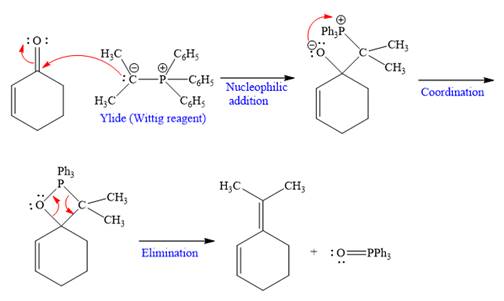
Explanation of Solution
The given nucleophile ylide is highly reactive and adds irreversibly to the
In the first step, the given highly reactive ylide attack on the carbonyl carbon of the
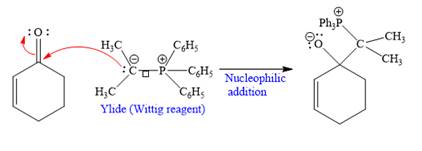
In the second step, the anion coordinates with
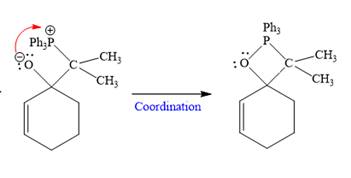
In the last step, Eliminates
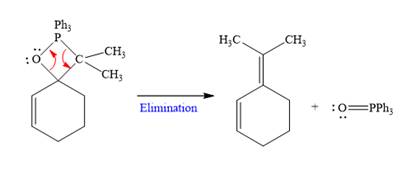
Nucleophilic addition of ylide (Wittig reagent) to the
(c)
Interpretation:
The detailed mechanism for the given reaction is to be drawn and the major product of the reaction is to be predicted.
Concept introduction:
The addition reaction mechanism dominates on whether the nucleophile adds to the carbonyl carbon reversibly or irreversibly. Nucleophilic addition is irreversible or reversible depends on charge stability. Nucleophilic addition tends to be irreversible if the negative charge that develops in the adduct is substantially better stabilized than it is in the nucleophile. Nucleophilic addition to a carbonyl carbon tends to be irreversible when it involves a very strong nucleophile like
Answer to Problem 17.24P
The major product and detailed mechanism for the given reaction are:
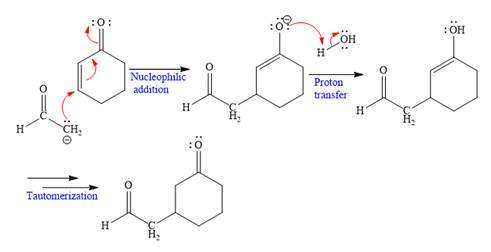
Explanation of Solution
The nucleophile
In the first step,
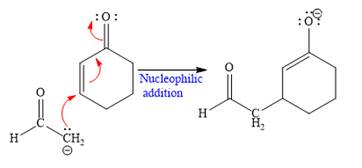
In the second step, this enolate anion is then protonated by an acid workup.
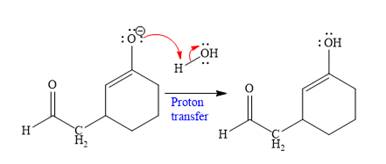
In the last step, tautomerization takes place and produces a ketone with a conjugate addition product.
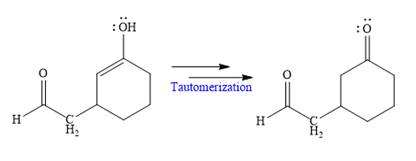
Nucleophilic addition of
(d)
Interpretation:
The detailed mechanism for the given reaction is to be drawn and the major product of the reaction is to be predicted.
Concept introduction:
The addition reaction mechanism dominates on whether the nucleophile adds to the carbonyl carbon reversibly or irreversibly. Nucleophilic addition is irreversible or reversible depends on charge stability. Nucleophilic addition tends to be irreversible if the negative charge that develops in the adduct is substantially better stabilized than it is in the nucleophile. Nucleophilic addition to a carbonyl carbon tends to be irreversible when it involves a very strong nucleophile like
Answer to Problem 17.24P
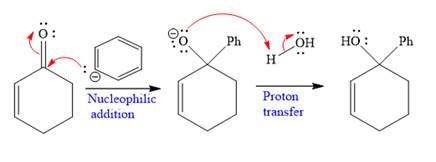
Explanation of Solution
The given nucleophile
In the first step,
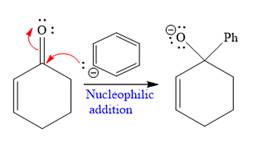
In the second step, this anion is then protonated by acid workup and formed a direct addition product.
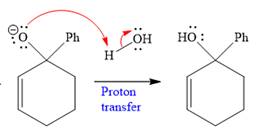
Nucleophilic addition of Grignard reagent to the
(e)
Interpretation:
The detailed mechanism for the given reaction is to be drawn and the major product of the reaction is to be predicted.
Concept introduction:
The addition reaction mechanism dominates on whether the nucleophile adds to the carbonyl carbon reversibly or irreversibly. Nucleophilic addition is irreversible or reversible depends on charge stability. Nucleophilic addition tends to be irreversible if the negative charge that develops in the adduct is substantially better stabilized than it is in the nucleophile. Nucleophilic addition to a carbonyl carbon tends to be irreversible when it involves a very strong nucleophile like
Answer to Problem 17.24P
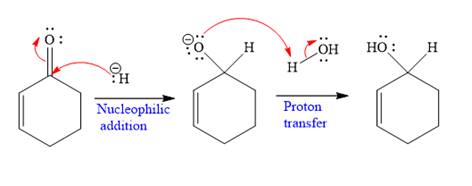
Explanation of Solution
The given nucleophile
In the first step,
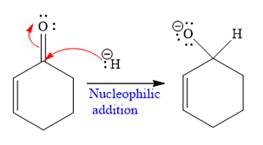
In the second step, this anion is then protonated by acid workup and formed a direct addition product.
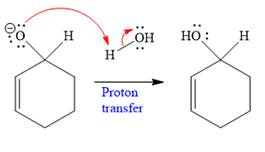
Nucleophilic addition of
Want to see more full solutions like this?
Chapter 17 Solutions
Organic Chemistry: Principles and Mechanisms (Second Edition)
- Curved arrows are used to illustrate the flow of electrons. Use the reaction conditions provided and follow the arrows to draw the intermediate and product in this reaction or mechanistic step(s). Include all lone pairs and charges as appropriate. Ignore stereochemistry. Ignore inorganic byproducts. H :0: CH3 O: OH Q CH3OH2+ Draw Intermediate protonation CH3OH CH3OH nucleophilic addition H Draw Intermediate deprotonation :0: H3C CH3OH2* protonation H 0: H CH3 H.arrow_forwardPredicting the reactants or products of hemiacetal and acetal formation uentify the missing organic reactants in the following reaction: H+ X+Y OH H+ за Note: This chemical equation only focuses on the important organic molecules in the reaction. Additional inorganic or small-molecule reactants or products (like H2O) are not shown. In the drawing area below, draw the skeletal ("line") structures of the missing organic reactants X and Y. You may draw the structures in any arrangement that you like, so long as they aren't touching. Explanation Check Click and drag to start drawing a structure. ? olo 18 Ar © 2025 McGraw Hill LLC. All Rights Reserved. Terms of Use | Privacy Center | Accessibilityarrow_forwardcan someone please answer thisarrow_forward
- Please, please help me figure out the the moles, molarity and Ksp column. Step by step details because I've came up with about three different number and have no idea what I'm doing wrong.arrow_forwardwhat reagents are used to get this product from this reactant? Br OCH3arrow_forwardcan someone answer this pleasearrow_forward
- can someone do the reaction mechanism for this reaction and draw the molecules for Q2 and q3arrow_forwardIn this question, the product of the aldol condensation is shown. What would be the reactants for this product? Please provide a detailed explanation, as well as a drawing showing how the reactants will react to produce the product.arrow_forward7. Propene undergoes a hydration reaction with water in the presence of an acid. a. There are two possible products for this reaction, both with the formula C,H,O. Show their structural formulas and names. (A1, B2) SCH4UR Name: (answer for part a. here!) VER 3 2021-2022 b. Which of the two products do you predict will form. Explain your choice using details from your learning. (B3)arrow_forward
- What are the major products of the following organic reaction? Please include a detailed explanation as well as a drawing as to how the reaction proceeds.arrow_forwardWhat are the major products of the following reaction? Please provide a detailed explanation and a drawing to show how the reaction proceeds.arrow_forwardWhat are the major products of the following organic reaction? Please include a detailed explanation as well as a drawing as to how the reaction proceeds.arrow_forward
 ChemistryChemistryISBN:9781305957404Author:Steven S. Zumdahl, Susan A. Zumdahl, Donald J. DeCostePublisher:Cengage Learning
ChemistryChemistryISBN:9781305957404Author:Steven S. Zumdahl, Susan A. Zumdahl, Donald J. DeCostePublisher:Cengage Learning ChemistryChemistryISBN:9781259911156Author:Raymond Chang Dr., Jason Overby ProfessorPublisher:McGraw-Hill Education
ChemistryChemistryISBN:9781259911156Author:Raymond Chang Dr., Jason Overby ProfessorPublisher:McGraw-Hill Education Principles of Instrumental AnalysisChemistryISBN:9781305577213Author:Douglas A. Skoog, F. James Holler, Stanley R. CrouchPublisher:Cengage Learning
Principles of Instrumental AnalysisChemistryISBN:9781305577213Author:Douglas A. Skoog, F. James Holler, Stanley R. CrouchPublisher:Cengage Learning Organic ChemistryChemistryISBN:9780078021558Author:Janice Gorzynski Smith Dr.Publisher:McGraw-Hill Education
Organic ChemistryChemistryISBN:9780078021558Author:Janice Gorzynski Smith Dr.Publisher:McGraw-Hill Education Chemistry: Principles and ReactionsChemistryISBN:9781305079373Author:William L. Masterton, Cecile N. HurleyPublisher:Cengage Learning
Chemistry: Principles and ReactionsChemistryISBN:9781305079373Author:William L. Masterton, Cecile N. HurleyPublisher:Cengage Learning Elementary Principles of Chemical Processes, Bind...ChemistryISBN:9781118431221Author:Richard M. Felder, Ronald W. Rousseau, Lisa G. BullardPublisher:WILEY
Elementary Principles of Chemical Processes, Bind...ChemistryISBN:9781118431221Author:Richard M. Felder, Ronald W. Rousseau, Lisa G. BullardPublisher:WILEY





